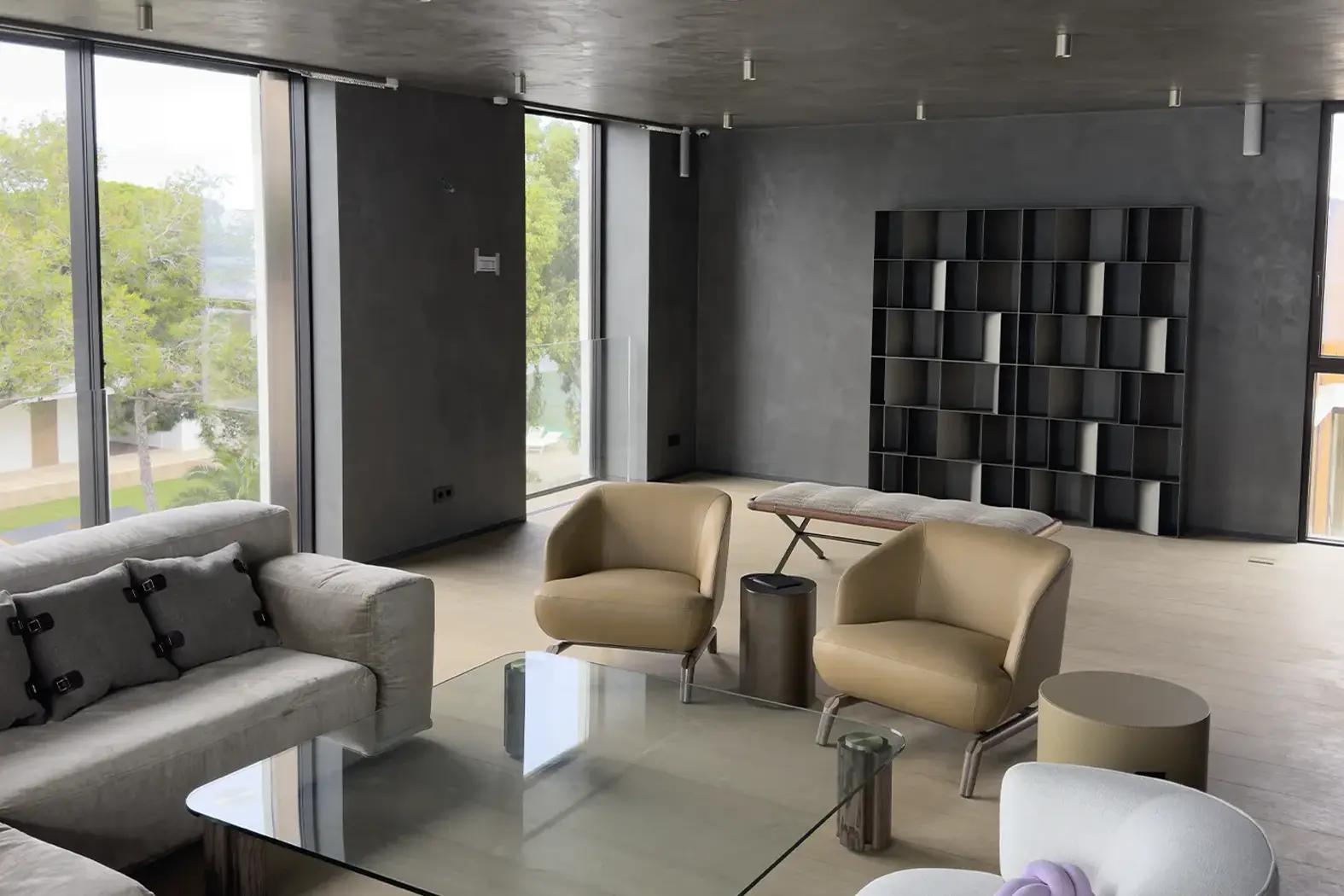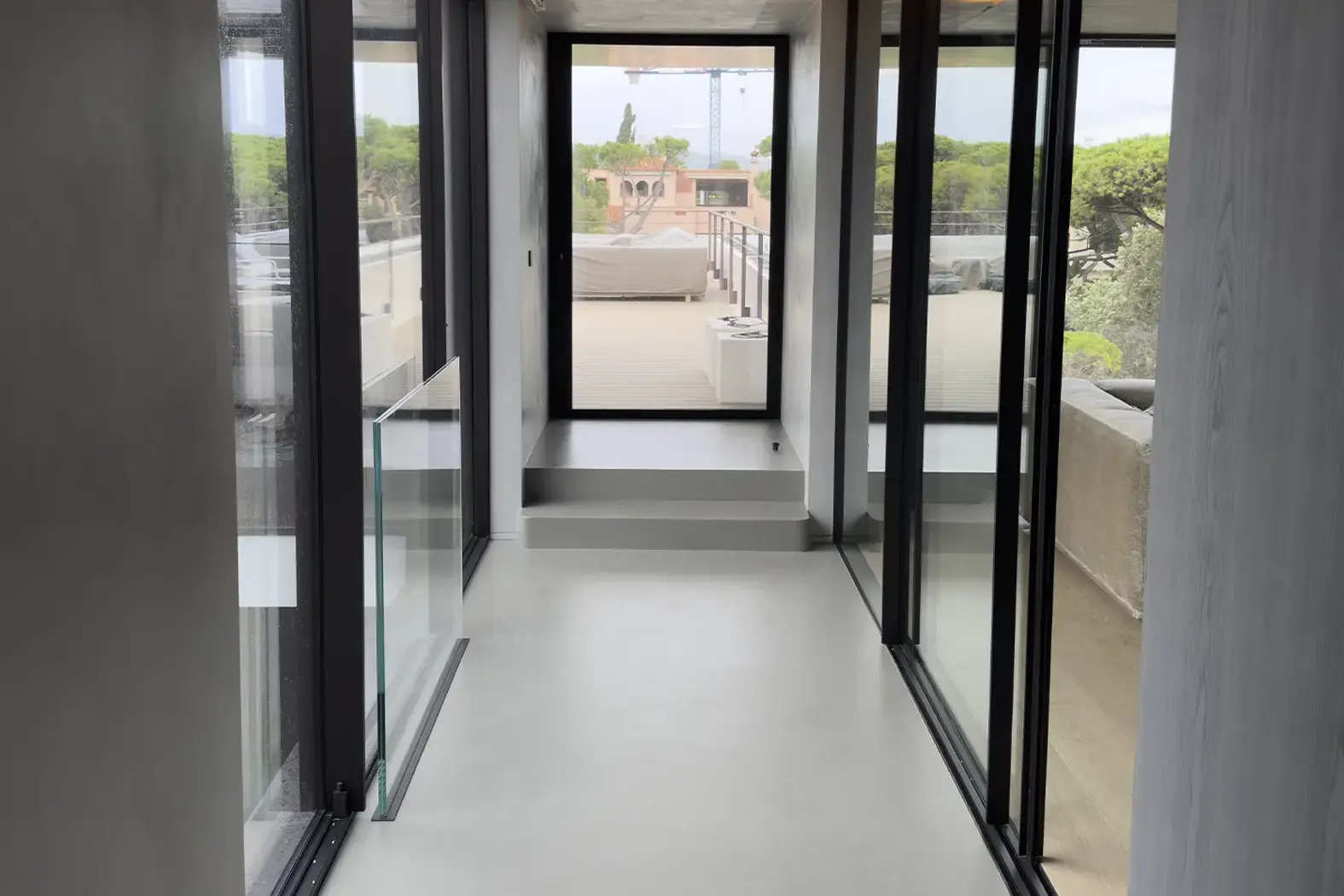Blog / Microcement vs Tadelakt
Discover the best choice between microcement and Tadelak, guiding your decision for your next interior design project.
TOPCRET
8-9 minutes time reading

We often receive inquiries about Tadelakt and its distinctions from microcement. It’s a topic that frequently arises in our discussions here at Topcret. And it’s one we’re more than happy to delve into.
Here at Topcret, we’ve seen it all when it comes to both microcement and Tadelakt. We’ve worked with different formulations, experimented with various application methods, and seen the incredible range of aesthetics that these materials can achieve.
So, when someone asks us about the differences between Tadelakt and microcement, we’re ready to dive deep. We’ve got the expertise and firsthand experience to break it all down for you. And trust me, there’s a lot to talk about. From the ingredients to the application process to the final look and feel, each material brings its own unique qualities to the table.
But hey, don’t just take our word for it. We’ve got a whole treasure trove of knowledge waiting for you right here on our website. So, if you’re curious to learn more about the world of microcement and Tadelakt, stick around. We’ve got plenty to share.
Microcement and tadelakt are two popular choices for surfacing materials utilised in interior design, each with its own unique characteristics and applications. Understanding the differences between these two options is essential for making an informed decision about which one best suits your needs and preferences.
Microcement, often referred to as micro concrete, stands out as a versatile substance ideal for both decorative and protective purposes. It comprises a blend of cement, aggregates, and polymers, rendering it incredibly adaptable for a range of surfaces including floors, walls, and countertops. The application process involves delicately layering multiple thin coats of microcement, followed by meticulous polishing to achieve a flawlessly smooth and durable surface. Its remarkable waterproof properties make microcement particularly well-suited for use in wet areas such as bathrooms and kitchens, offering both style and practicality in one elegant package.
Tadelakt, originating from Morocco, is a traditional lime plaster known for its unique application process and luxurious appearance. Applied in thick layers and polished by hand, Tadelakt creates a natural, soft finish with a subtle sheen. While requiring skill and time for traditional application, modern premixed variations offer easier installation. Tadelakt is prized for its water resistance, making it a desirable option for various interior and exterior surfaces.
Both traditional Tadelakt and Microcement offer excellent performance when applied correctly. When comparing traditional Tadelakt and our Microcement, several notable differences emerge:
While Tadelakt relies on lime plaster, a tried-and-tested material with its own merits, microcement, being cement-based, offers a modern twist with enhanced durability and versatility, making it a preferred choice for contemporary design projects.
Traditional Tadelakt undeniably showcases a unique charm with its thick, soft, undulating texture and subtle sheen, evoking a sense of timeless elegance. However, microcement, though challenging to replicate Tadelakt’s rounded lines without a suitable basecoat, offers its own allure with a sleek, industrial aesthetic that complements modern interiors effortlessly.
Original Tadelakt, cherished for its natural essence and authenticity, indeed embodies a sense of heritage. Yet, microcement, infused with resins for enhanced flexibility, brings a touch of innovation to the table, offering greater adaptability to diverse design needs without compromising on quality or performance.
While properly applying traditional Tadelakt demands skill and finesse to ensure longevity and performance, microcement, with its inherent strength and forgiving nature, provides a more accessible option for both seasoned professionals and DIY enthusiasts alike. The learning curve for achieving an impeccable finish with microcement is gentler, allowing for greater experimentation and creativity without sacrificing quality.
Despite Tadelakt’s inherent strength, its susceptibility to chipping and staining, typical of lime plaster, necessitates regular maintenance, including soaping or waxing, to preserve its water-resistant properties. In contrast, microcement, with its cement-based composition, offers superior durability and resilience against wear and tear, reducing the need for stringent upkeep and providing peace of mind for homeowners and designers alike.
Traditional Tadelakt offers a distinctive texture with a smooth, polished finish, while microcement tends to have a more industrial, contemporary texture, often with variations in surface appearance.
Applying traditional Tadelakt involves a labour-intensive process of burnishing and polishing, requiring specialised skills and knowledge of traditional techniques. Microcement application, while also requiring skill, typically involves a simpler process with fewer steps.
Tadelakt’s colour palette is often limited to natural earth tones due to its composition, while microcement offers a broader range of customizable microcement colours, including vibrant hues and modern shades.
Traditional Tadelakt is typically applied to traditional substrates like lime plaster or masonry, while microcement can be applied to a wider range of surfaces, including existing tiles, concrete, wood, and even metal, with proper preparation.

At Topcret, we prioritise excellence. Our microcements boast unparalleled performance and durability, ensuring a crack-free experience for professionals and homeowners alike.
At Topcret, we understand that these challenges arise primarily from improper application techniques. That’s why we offer a team of professional microcement applicators dedicated to ensuring flawless results for every project, whether residential or commercial.
In the realm of high-performance coatings and plasters, understanding the nuanced technical properties of materials like microcement and tadelakt is crucial for professionals. These insights help in selecting the most efficient and durable solutions for their projects.
Below, we provide an in-depth comparative analysis that delves into the core technical differences between microcement and tadelakt. This examination covers aspects such as composition, mechanical strengths, flexibility, and environmental adaptability.
The aim is to equip architects, designers, and builders with essential data to make informed decisions.
| Technical Aspect | Microcement | Tadelakt |
|---|---|---|
| Composition | Cement, fine aggregates, polymers, and resins. | Lime, black soap made from olives, and natural color pigments. |
| Tensile Strength | High tensile strength due to polymers (approx. 2-3 MPa). | Lower tensile strength typical of lime plasters (approx. 0.5-1.5 MPa). |
| Compressive Strength | Approximately 30-50 MPa, depending on the specific product and application method. | Approximately 5-20 MPa, depending largely on the curing process and application thickness. |
| Flexibility and Elasticity | High elasticity, can withstand minor substrate movements without cracking. | Low elasticity, more susceptible to cracking with substrate movement. |
| Permeability | Low permeability to water, vapour-permeable allowing substrate to breathe. | Vapour-permeable but can absorb water if not sealed properly, risking degradation. |
| Application Thickness | Typically 2-3 mm, can be layered up to 8 mm without losing integrity. | Typically applied at a thickness of about 5-20 mm, requiring more material for comparable area coverage. |
| Cure Time | Sets within 24-48 hours, fully cured in about 28 days. | Requires slow curing, often taking several days to initially set and up to a month to fully cure. |
| Thermal Conductivity | Lower thermal conductivity, providing some insulation properties. | Higher thermal conductivity, less insulative compared to microcement. |
| Installation Environment | Adaptable to various climates and indoor conditions. | Best in dry, controlled environments; performance may decrease in humid or fluctuating climates. |
| Lifespan and Durability | Highly durable with a lifespan of 25+ years if maintained properly. | Durable with a similar lifespan, but maintenance and environmental factors are more critical to longevity. |
Such properties make microcement an exemplary choice for modern construction and renovation projects, aligning with the demands of contemporary building standards.
So, when it comes to making the decision between tadelakt and microcement, it’s all about understanding what matters most to you.Tadelakt offers a unique, softly undulating appearance and appeals to those who prioritize natural materials in wet areas. Of course, it’s important to note that tadelakt does require a bit of upkeep, and it’s best applied by someone with experience in handling this unique material.
However, if you’re in the market for a finish that’s not only seamless and highly durable but also low-maintenance, especially if you’re considering applying it to your floors, then our Mercadier Decoration microcement is definitely the way to go. With microcement, you get the best of both worlds – a beautiful finish that won’t chip and requires minimal maintenance. It’s the perfect choice for those who want both style and practicality without any compromise.
Explore the versatility and durability of microcement with TOPCRET. Our range of decorative coatings offers seamless finishes for both residential and commercial spaces. Contact us today to learn more about our products and take the next step towards transforming your home or business.
CONTACT
NEWSLETTER

PROFESIONALS
COMPANY
CONTACT
NEWSLETTER
